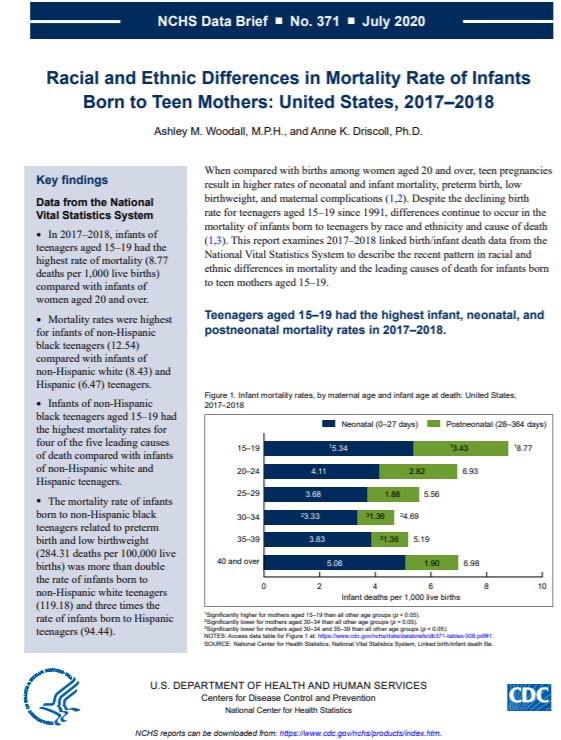Racial and Ethnic Differences in Mortality Rate of Infants Born to Teen Mothers: United States, 2017–2018
Posted on by Questions for Ashley Woodall, Health Statistician and Lead Author of “Racial and Ethnic Differences in Mortality Rate of Infants Born to Teen Mothers: United States, 2017–2018.”
Questions for Ashley Woodall, Health Statistician and Lead Author of “Racial and Ethnic Differences in Mortality Rate of Infants Born to Teen Mothers: United States, 2017–2018.”
Q: Why did you decide to focus on teenagers for this report?
AW: There has not been much research on infant mortality using national data that focuses on specific maternal age groups. Teenagers are an age group of particular interest because infants born to teenagers have higher infant mortality rates compared with infants born to women in older age groups. Consequently, we wanted to explore the recent patterns in infant mortality for teenagers in the United States.
Q: Can you summarize some of the findings?
AW: In 2017–2018, infants born to teenagers aged 15–19 had the highest rate of mortality (8.77 deaths per 1,000 live births) compared with infants born to women aged 20 and over. Among teenagers, infants of non-Hispanic black females had the highest infant mortality rate (12.54) compared with non-Hispanic white (8.43) and Hispanic (6.47) females. Among the five leading causes of infant death, the largest racial and ethnic difference in mortality rates was found for preterm- and low-birthweight-related causes, where rates were two to three times higher for infants of non-Hispanic black teenagers (284.31 per 100,000 live births) than infants of non-Hispanic white (119.18) and Hispanic (94.44) teenagers.
Q: Was there a specific finding in the data that surprised you from this report?
AW: We were surprised by the large racial and ethnic disparity in deaths for preterm- and low-birthweight-related causes. This finding suggests that preterm birth and low birthweight are significant contributing factors for death among infants born to non-Hispanic black teenagers.
Q: Can you explain the difference between total infant, neonatal, and postneonatal mortality rates?
AW: Infant mortality is the death of a baby before his or her first birthday. It is calculated by dividing the number of infant deaths during a calendar year by the number of live births reported in the same year. It is expressed as the number of infant deaths per 1,000 live births. Neonatal mortality rate is the death of a baby during the first 27 days after birth, per 1,000 live births. Postneonatal mortality rate is the death of a baby between 28 days to under 1 year after birth, per 1,000 live births.
Q: What is the take home message for this report?
AW: The different mortality patterns seen among infants born to teenage mothers illustrate the racial and ethnic disparities in infant mortality and suggest that preterm birth and low birthweight are major public health concerns for infants born to non-Hispanic black teenagers.
Posted on by

